项目架构开发:服务层(上)
上一次(即昨天),我们完成了业务逻辑层的演示;传送门:项目架构开发:业务逻辑层之领域驱动失血模型
设计上虽然还不是太优雅,但是距离真正的OO编程又更近了一步,而且也保留了事务脚本模式的简单快捷的特性
只要后续把Model层丰富起来,那就算是掌握了另一种软件开发模式,而且也是整个思想上的转变。
本章我们来完成在业务逻辑层之上的服务层;
服务层并不是必须的,在有一定复杂度的应用程序中,服务层非常有必要创建;而与之相反的就是,
在一些业务逻辑简单的系统中,服务层可能仅仅充当分发功能,没有多余的工作需要组织,这时服务层就显得多余;
而且,服务层一般还与客户端有关系(Web、Winform);如果是Web,在同一系统内,服务层就没有大多必要,除非是跨系统的服务调用;
如果是Winform,那服务层就比较常用,因为Winform是C/S模式,物理层上天生与服务器端分离。
若是从C端远程调用应用逻辑,那有可能在长距离的远程调用中花费太多的时间,而加入服务层情况就会不同
服务层就是为UI何应用逻辑层之间提供一个数据交互的契约,简单点说就是从C端发送一组参数,在S端进行逻辑运算,
因为一般情况下S端与数据库在同一局域网下,访问速度比前者快很多,效率也大大提高
若没有服务层,则需要从UI直接与后端应用程序通信,交互次数大大的增加,通信距离也大大的影响程序性能
我们开始吧。
1、应用逻辑,创建新登录用户
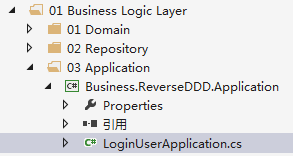
1 public bool Add(AddRequest entity) 2 { 3 this.repository.Add(new LoginUser() 4 { 5 Id = Guid.NewGuid(), 6 LoginName = entity.LoginName, 7 Password = entity.Password, 8 IsEnabled = entity.IsEnabled, 9 CreateTime = DateTime.Now 10 }); 11 this.unitOfWork.Commit(); 12 13 return true; 14 } 15 16 public bool Check(string loginName) 17 { 18 return this.repository.Count(w => w.LoginName == loginName) > 0; 19 }
这里添加了2个方法,功能不解释了
现在,我们假设UI层与应用层相距甚远,那直接调用显然是不妥的,我们创建一个服务项目来完成这个功能
2、新建WCF项目

IUserService.cs
1 [ServiceContract] 2 public interface IUserService 3 { 4 [OperationContract] 5 bool Add(AddRequest entity); 6 7 [OperationContract] 8 UserList GetAll(); 9 } 10 11 [DataContract] 12 public class UserList 13 { 14 [DataMember] 15 public IEnumerable<GetAllResponse> Items { get; set; } 16 }
UserService.svc
1 public class UserService : IUserService 2 { 3 public bool Add(AddRequest entity) 4 { 5 var loginUserApp = new LoginUserApplication(); 6 if (loginUserApp.Check(entity.LoginName)) 7 { 8 throw new Exception("登录名称已被占用!"); 9 } 10 11 loginUserApp.Add(entity); 12 return true; 13 } 14 15 public UserList GetAll() 16 { 17 var loginUserApp = new LoginUserApplication(); 18 var wcf = new UserList(); 19 wcf.Items = loginUserApp.GetAll(); 20 21 return wcf; 22 } 23 }
也很简单明了,在Add方法中我们完成以后的校验与新增
3、新建客户端测试项目
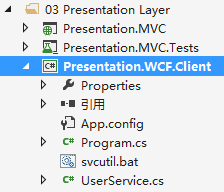
UserService.cs
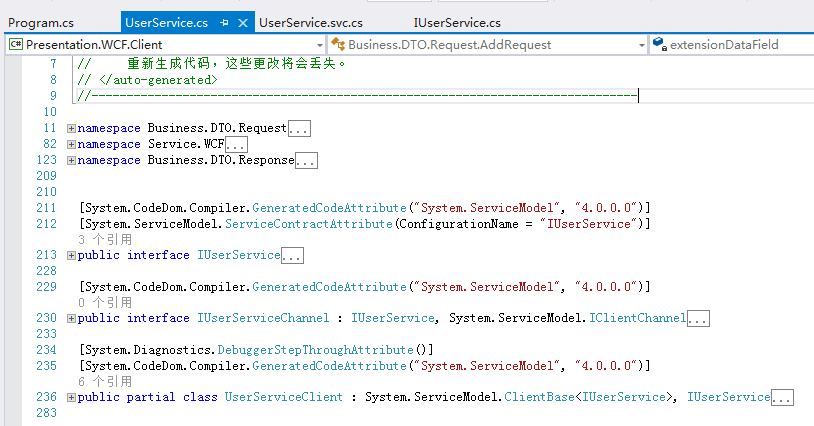
这个类是系统自动生成的,不用我们自己写
Program.cs
1 class Program 2 { 3 static void Main(string[] args) 4 { 5 var userClient = new UserServiceClient(); 6 var addRequest = new Business.DTO.Request.AddRequest() 7 { 8 LoginName = "LoginName" + Guid.NewGuid().ToString(), 9 Password = "Password", 10 IsEnabled = 1 11 }; 12 userClient.Add(addRequest); 13 Console.WriteLine(string.Format("Add finish: {0}", addRequest.LoginName)); 14 15 var result = userClient.GetAll(); 16 foreach (var item in result.Items) 17 { 18 if(item.LoginName == addRequest.LoginName) 19 Console.WriteLine(string.Format("Found you: {0}", item.LoginName)); 20 } 21 22 Console.WriteLine("totle:" + result.Items.Count()); 23 Console.WriteLine(); 24 25 Console.ReadKey(); 26 } 27 }
看看效果

成功了啊
上边演示的是适合C/S架构,我们再来看看B/S的
4、新建WebApi
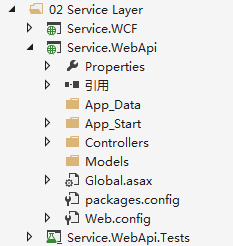
UserController.cs
1 public class UserController : ApiController 2 { 3 public IEnumerable<GetAllResponse> GetAll() 4 { 5 var loginUserApp = new LoginUserApplication(); 6 return loginUserApp.GetAll(); 7 } 8 9 public HttpResponseMessage Get(Guid id) 10 { 11 var loginUserApp = new LoginUserApplication(); 12 LoginUser loginUser = loginUserApp.Get(id); 13 if (loginUser == null) 14 { 15 return Request.CreateResponse(HttpStatusCode.NotFound); 16 } 17 18 return Request.CreateResponse(loginUser); 19 } 20 21 public bool Add(AddRequest user) 22 { 23 var loginUserApp = new LoginUserApplication(); 24 if (loginUserApp.Check(user.LoginName)) 25 { 26 throw new Exception("登录名称已被占用!"); 27 } 28 29 return loginUserApp.Add(user); 30 } 31 }
UserControllerTest.cs
1 public void Add() 2 { 3 var userController = new UserController(); 4 var flag = userController.Add(new AddRequest() 5 { 6 LoginName = "LoginName" + Guid.NewGuid().ToString(), 7 Password = "Password", 8 IsEnabled = 1 9 }); 10 11 Assert.AreEqual(true, flag); 12 } 13 14 [TestMethod] 15 public void GetAll() 16 { 17 var userController = new UserController(); 18 var list = userController.GetAll(); 19 int count = list.Count(); 20 21 Assert.AreEqual(true, count > 0); 22 }
运行看看效果

看来没什么问题,成功了
看看完整架构
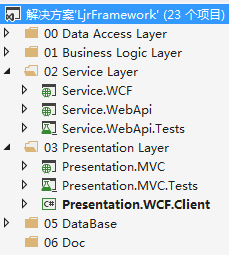




【推荐】国内首个AI IDE,深度理解中文开发场景,立即下载体验Trae
【推荐】编程新体验,更懂你的AI,立即体验豆包MarsCode编程助手
【推荐】抖音旗下AI助手豆包,你的智能百科全书,全免费不限次数
【推荐】轻量又高性能的 SSH 工具 IShell:AI 加持,快人一步
· AI与.NET技术实操系列:向量存储与相似性搜索在 .NET 中的实现
· 基于Microsoft.Extensions.AI核心库实现RAG应用
· Linux系列:如何用heaptrack跟踪.NET程序的非托管内存泄露
· 开发者必知的日志记录最佳实践
· SQL Server 2025 AI相关能力初探
· winform 绘制太阳,地球,月球 运作规律
· 震惊!C++程序真的从main开始吗?99%的程序员都答错了
· 【硬核科普】Trae如何「偷看」你的代码?零基础破解AI编程运行原理
· AI与.NET技术实操系列(五):向量存储与相似性搜索在 .NET 中的实现
· 超详细:普通电脑也行Windows部署deepseek R1训练数据并当服务器共享给他人